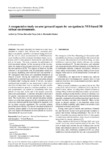A comparative study on user gestural inputs for navigation in NUI‑based 3D virtual environments

Ver/
Use este enlace para citar
http://hdl.handle.net/2183/35410Coleccións
- Investigación (ETSECCP) [826]
Metadatos
Mostrar o rexistro completo do ítemTítulo
A comparative study on user gestural inputs for navigation in NUI‑based 3D virtual environmentsData
2021Cita bibliográfica
Barneche-Naya, V., Hernández-Ibañez, L.A. A comparative study on user gestural inputs for navigation in NUI-based 3D virtual environments. Univ Access Inf Soc 20, 513–529 (2021). https://doi.org/10.1007/s10209-020-00766-z
Resumo
[Abstract] This paper describes the results of a case study intended to compare three different user movement paradigms (metaphoric,
symbolic and natural) designed to control the visit of virtual environments for a NUI-based museum installation. It also
evaluates the effects of previous expertise with 3D video games in the results for users that took part in the study. The study
evaluates the performance of each movement scheme for the navigation of the environment, the degree of intuitiveness
perceived by the users, and the user experience. The analysis is based on the data collected in an experiment with 28 participants
sorted into two groups, separating users with less previous expertise in 3D videogames from those who considered
themselves as frequent players. During the experiment, the participants completed two different tasks with every movement
scheme in random order. During the course of the test, the system monitored and recorded the user movements in order to
extract relevant data about time to complete the task, number of collisions and time spent in a collision condition. A post-task
questionnaire was carried out immediately after completion of every task. At the end of the session, users also took a test
questionnaire. In addition, the authors asked users for general comments and recommendations for improvement. The results
show that the natural movement scheme stands out as the most adequate for the contemplation of the virtual environment and
the most balanced at a general level for the three variables considered. The symbolic scheme proved the most efficient. The
natural movement scheme and symbolic scheme appear to be the most appropriate to navigate such digital environments as
those present in museum installations for any kind of user.
Palabras chave
User experience
Natural user interfaces
Virtual navigation
Virtual museum
Natural user interfaces
Virtual navigation
Virtual museum
Descrición
This version of the article has been accepted for publication, after peer review (when applicable) and is subject to Springer Nature’s AM terms of use, but is not the Version of Record and does not reflect post-acceptance improvements, or any corrections. The Version of Record is available online at: https://doi.org/10.1007/s10209-020-00766-z
Versión do editor
ISSN
1615-5297





